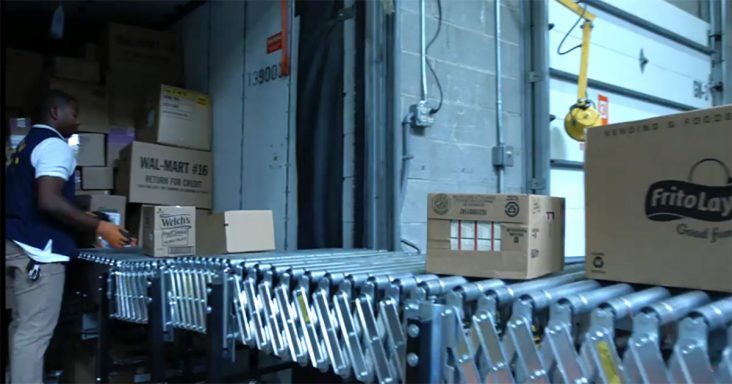Retail inventories rise modestly ahead of the holidays
by November 28, 2018 4:00 pm 1,060 views

A Walmart employee helps unload a truck at a Supercenter in Rogers, where the retailer is testing a fast unloader to expedite the movement of freight from the truck out onto the sales floor.
Retailers large and small are expecting a solid sales performance throughout the holiday season, and if the recent Thanksgiving weekend is any indication, it could be a banner year.
According to data from Adobe Analytics, consumers spent $58.8 billion at retail between Thanksgiving Day through Cyber Monday. That’s an increase of 19.9% from a year ago.
Retailers from Walmart to Target ordered deep this year ahead of Black Friday, in part because of the absence of Toys R Us as each hoped to win some of the toy market share. Retailers have said they are pleased with sales recorded during the weekend, and report overall good store traffic and online trips. Being able to make sales begins with having the items in stock that consumers want. That means gambling on inventory well ahead of Black Friday.
A recent report from Brad Delco, an analyst with Stephens Inc. of Little Rock, found inventory among the largest retailers was inflated in the recent third-quarter earnings cycle as they geared up for a big peak holiday shopping season.
“We saw signs of inventory growth, outpacing sales growth on a year-over-year basis, a continuation of a stable national inventory /sales ratio, and commentary around running more managed / leaner inventory levels into the peak retail season,” Delco wrote in the report. “We believe some of the inflated inventory levels were a result of freight pulled forward ahead of peak shopping … We look for more freight commentary in the coming months as we should get a more concrete sense of holiday peak season demand and capacity constraints, and a clearer view of the 2019 contractual rate environment.”
The Stephens report analyzed Amazon, Home Depot, Kohl’s, Macy’s, Target, T.J. Maxx and Walmart to study inventory growth from the second quarter to the third. Delco said he saw consistent themes around inventory outpacing sales growth with inventory levels up 5% relative to a 3.2% increase in sales from a year ago. (Those stats exclude Amazon.)
Delco said on a sequential basis, inventories grew 21.6% on average during the third quarter heading into the peak shopping season. That slightly outpaced the five-year average sequential growth of 18.8%.
He said the earlier occurrence of Thanksgiving this year also meant retailers had to be stocked sooner, and there should be significant draw-down in inventory levels following the strong sales from pre-Thanksgiving through Cyber Monday. Delco said overall retail inventories in the U.S. have come down from their highs in 2016.
Walmart U.S. CEO Greg Foran has said reeling in inventory levels has been a top priority over the past couple of years. He said in the process of reducing inventory the retailer has also increased its in-stock percentages because the back rooms are cleaner and there are not as many containers parked behind stores holding excess inventory as in previous years.
Stephens reports Walmart grew inventories by just 0.5% year-over-year in the third quarter. Between the second quarter and third quarter, though, inventories at the retail giant rose 20%. Sales revenue declined 2.4% from the sequential quarters and sales revenue rose 1.4% from a year ago.
Walmart executives said during the recent quarter it was well positioned for the holiday and toys were a big focus. Walmart told the media it had bought deep for the holiday season, and the build-up of inventory likely related to expected strong holiday sales. Walmart has said inventory management is still a major focus, and it’s pleased with the progress in that area.
Compared to its competitors, Walmart’s inventory growth between the second and third quarters fell in the middle of the pack. Amazon and Home Depot were lower at 7% and 5.1%, respectively, but Kohl’s, Macy’s, Target and T.J. Maxx each grew inventory levels higher than Walmart. The highest rate of 44.2% was at Macy’s, followed by Target at 36%. Compared to a year ago, Walmart had the lowest inventory increase at 0.5%. Macy’s was the next lowest at 1.2%. Amazon, Target and T.J. Maxx each grew inventories by more than 15.5% from a year ago.
Walmart grew its year-over-year sales slower than competitors in the group. Amazon led the pack with year-over-year sales growth of 29.3% T.J. Maxx was the only other retailer with sales growth in double digits (12.1%).
Overall, retailers seek to grow sales ahead of inventories because that indicates leaner operations and helps control costs which can erode profits. From the seven retailers in the report, five of them grew sales ahead of inventory in the third quarter. Amazon led the pack with sales growth of 29.3% and inventory rising 15.7%.
Home Depot grew sales at 9.9% while inventory rose by 5.1%. Kohl’s grew its sales by 6.8% against inventory levels rising by 4.6%. Macy’s grew sales 5.8% while inventory level rose 1.2%. Walmart was the last retailer accomplishing this feat with sales rising 1.4%, against inventory growth of 0.5% year over year.
As retailers sell down their peak inventory throughout the holiday season, there is less need for deeper discounting, which has occurred in past years as excess inventory lingered in stores well after the holiday shopping season. That should be positive for margins as retailers wind down their fiscal year and report earnings in early 2019.
